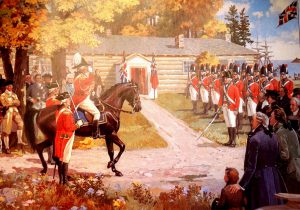On today’s date in 1792, John Graves Simcoe assumed office in Newark (present-day Niagara-on-the-Lake, Ont.) as the first Lieutenant-Governor of Upper Canada.
Two years later, Simcoe ordered a halfpenny token to be struck for the pre-Confederation province of British North America. It’s believed only a handful of examples ever existed. Struck in silver and copper by the Soho Mint – a minting operation established by Matthew Boulton, a business partner of Scottish engineer James Watt, in 1788 – the tokens were engraved by the French die engraver Noël-Alexandre Ponthon.
“Not long after John Simcoe took office as Governor of Upper Canada, he addressed the severe copper coin shortage in the province,” reads the catalogue for Heritage Auctions’ January 2019 NYINC Signature Sale. “Boulton & Watt (Soho Mint) in England was approached to produce a halfpenny token. Pattern pieces were prepared and sent to Canada in 1794 for approval. At that point, Simcoe forwarded the samples to the Home Office for approval. Home Office denied the proposal and instead arranged for a shipment of worn Tower halfpence from Ireland. So, Upper Canada got castoffs instead of a beautiful new coinage. The so-called ‘originals’ or approval samples for the proposed coinage have delicate digits in the date on the obverse, with the 17 and 94 separated by a wide gap, and on the reverse have Rs with straight tails and round Os. Fewer than 25 are believed to have survived.”

Upper Canada’s first legislative assembly was held in present-day Niagara-on-the-Lake, Ont., on Sept. 17, 1792, about two months after John Graves Simcoe was sworn in as the province’s first Lieutenant-Governor. (Photo via Toronto Reference Library)
Last year, long-time U.S. numismatist Q. David Bowers, the co-founder of Stack’s Bowers auction house, began seeking information on the 1794 Upper Canada halfpenny for a book exploring mottos and inscriptions on money. The token includes an obverse inscription reading, “FERTILITATEM DIVITIAS QUE CIRCUMFERREMUS,” of which Bowers is pursuing the translation or meaning, he wrote in a July 31 blog post.
Simcoe previously served as a military officer and earned recognition during the American Revolution as well as for his 1793 creation of the province’s capital at present-day Toronto, which he called York. His regiment still exists today as the Queen’s York Rangers.
1993 TRADE TOKEN
In 1993, Simcoe was also featured on a $2 trade token issued by London, Ont.
That same year, he was commemorated alongside his wife Elizabeth Posthuma Gwillim on a medal marking the 200th anniversary of York’s founding.
Simcoe remained in office until July 20, 1796, and died in England a decade later in 1806. He was buried in Wolford Chapel on the Simcoe family estate near Honiton, Devon.


